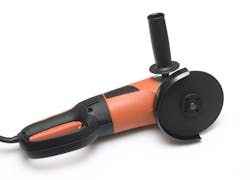Best Practices for Safely Using an Angle Grinder
When the batteries for 4.5-in. angle grinders started coming in larger configurations, the motors had more torque, higher RPM, and sufficient run-time for nearly any project. Thus, these tools became increasingly desirable for use in the field even among electricians.
You can do all kinds of things, from quickly cutting strut to grinding down unused metal studs to cutting off seized T-nuts. It used to be you’d have to attempt these things using a saw, which in many cases just wasn’t practical. The grinder also lets you quickly clean up jagged edges from botched cuts, debur a drilled hole, or remove the stripped thread portion of a bolt so you can get the nut off. That’s assuming you are using a grinding wheel that is appropriate for the work.
You have several choices in grinding wheels (material, shape, etc.), and the right one for the job depends on the material you are grinding and how you need to grind it. Saw blades are also available for these grinders, but unlike the typical circular saw that spins at 5,500 RPM, some grinders spin at 12,000 RPM. The energy difference is offset to a large degree by the difference in blade diameter, but a grinder with a saw blade is more dangerous than a circular saw.
Let’s first address blade safety. All of the safety rules that apply to battery-powered circular saws also apply to grinders that are fitted out with saw blades instead of grinding wheels. And there are a lot of safety rules that apply to using a circular saw.
But there’s a key difference. A circular saw sits on the work piece and has a built-in guide or “sight” to help you avoid binding the blade. By contrast, you hold the grinder in your hand above the work piece and kind of wing it to make a straight cut. Thus, it’s not the appropriate tool for trying to make long, straight cuts. You can quickly cut a length of threaded rod or perhaps a 2 × 4. But understand the limitations of the tool.
Grinding seems straightforward enough, but things aren’t always as they seem. Here are some of the safety rules:
- Check the battery. Look for a crack or other damage. If practical, start charging it as your first step.
- Select the correct wheel for the particular job.
- Ensure the wheel isn’t damaged or excessively worn. If the wheel is out of round or damaged in any way, toss it.
- Take care when mounting the wheel. Double check before powering the grinder.
- Remove any combustibles from the area before starting a grinding operation. Assess containment needs to protect the environment and people; you may need to put a canvas tarp on the floor, cover a nearby drain, cover a nearby HVAC vent, erect a screen, etc.
- Ensure you have the proper PPE. If you’re grinding metal, for example, at the very least you will need to wear a dust mask that is firmly secured (pinch the nose piece down and wear the strap tight) long sleeves, and suitable gloves. Goggles are preferable to safety glasses.
- Keep your face out of the waste stream of the grinder and keep it back from the work contact point as far is as reasonably practical. The PPE can do only so much.
- Use firm pressure, but don’t bear down hard. Excess pressure not only bogs the motor, but it also deforms the grinding wheel. Deforming the cutting wheel increases the odds that a piece of either the work or the wheel will fly at you.
- Don’t move the wheel rapidly to or around the work. Use slow movements.
- Focus on what you are doing, making sure you monitor how much pressure you are applying and what is going on at the work contact point.
- Clean up the work area when done. Any abrasive particles from the wheel and metal particles from the work must be completely removed. Also remove any covers you used (e.g., a drain cover).
- Check the wheel or blade you just used. If it’s not suitable for service, discard it. If you put it back with the grinder supplies and it’s the only wheel or blade you have when you start the next job and it has to be done ASAP, what you think is going to happen? Prevent that by not putting a damaged wheel or blade back.
